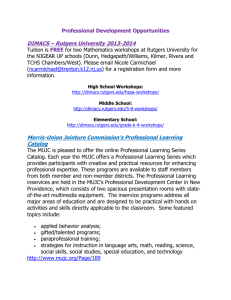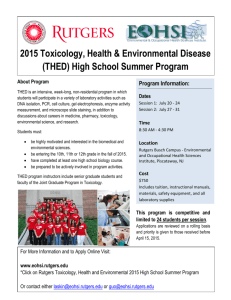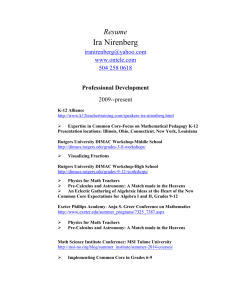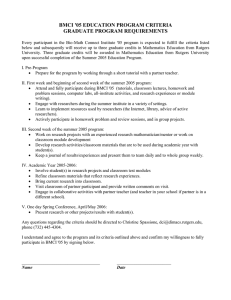Overview of Homeland Security Research at Rutgers
advertisement
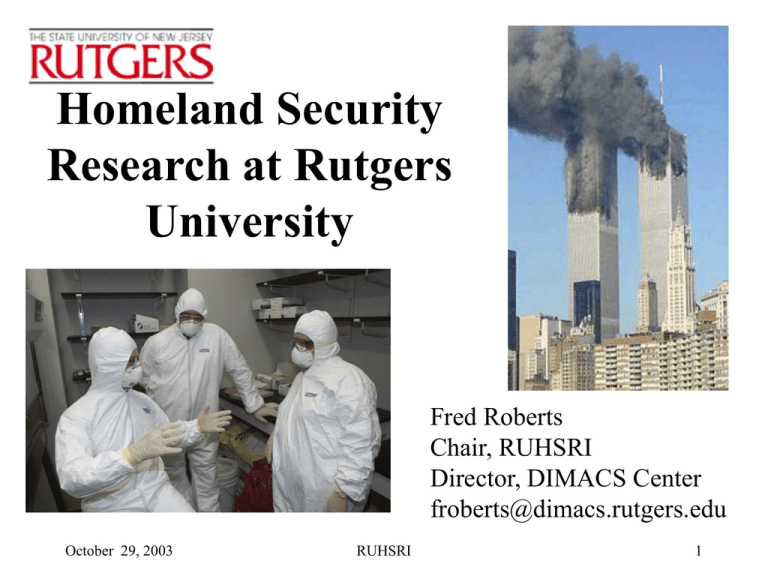
Homeland Security Research at Rutgers University Fred Roberts Chair, RUHSRI Director, DIMACS Center froberts@dimacs.rutgers.edu October 29, 2003 RUHSRI 1 Rutgers homeland security research arises from concerns about: •Physical safety •Transportation •Food and water supply •The fundamental technologies underlying our economic system (communications, computing) •The very working of our modern society The RU Homeland Security Research Initiative (RUHSRI) is aimed at coordinating homeland security research at Rutgers. October 29, 2003 RUHSRI 2 Existing efforts at Rutgers in homeland security research are widespread and impressive. Many could lead quickly to practical R&D programs and new business development and some already have. We present a selection of relevant current research. October 29, 2003 RUHSRI 3 Outline of Projects at Rutgers • Protecting the Critical Infrastructure • Surveillance/Detection • Responding to an Attack October 29, 2003 RUHSRI 4 PROTECTING THE CRITICAL INFRASTRUCTURE •Transportation and Border Security –Pattern recognition for machine-assisted baggage searches (Center for Advanced Information Processing: CAIP) –Border security: decision support software (Center for Information Management, Integration, and Connectivity: CIMIC) October 29, 2003 RUHSRI 5 PROTECTING THE CRITICAL INFRASTRUCTURE •Transportation and Border Security –Statistical analysis of flight/aircraft inspections (Statistics Dept.) –Port-of-entry inspection algorithms (Center for Discrete Math. & Theoretical Computer Science: DIMACS; and CIMIC) October 29, 2003 RUHSRI 6 PROTECTING THE CRITICAL INFRASTRUCTURE •Transportation and Border Security –Vessel tracking for homeland defense (Institute for Marine and Coastal Studies: IMCS) October 29, 2003 RUHSRI 7 PROTECTING THE CRITICAL INFRASTRUCTURE •Communication Security –Resource-efficient security protocols for providing data confidentiality and authentication in cellular, ad hoc, and WLAN networks (Wireless Information Network Laboratory: WINLAB) –Exploiting analogies between computer viruses and biological viruses (DIMACS) October 29, 2003 RUHSRI 8 PROTECTING THE CRITICAL INFRASTRUCTURE •Communication Security –Tunable, programmable, adaptive filters that can adapt to changing environmental conditions and offer a secure communications channel protected from interception by a hostile agent (School of Engineering) October 29, 2003 RUHSRI 9 PROTECTING THE CRITICAL INFRASTRUCTURE •Communication Security –Information privacy: •Privacy of healthcare data in syndromic surveillance (DIMACS) •Privacy-preserving data mining (Computer Science) •Legal issues surrounding privacy (Rutgers Center for the Study of Public Security: RCSPS) October 29, 2003 RUHSRI 10 PROTECTING THE CRITICAL INFRASTRUCTURE •Food and Water Supply Security –Food and water biosecurity initiative (Cook College) –Agroterrorism: Using economic weapons to prevent agroterror attacks (Food Policy Institute, Dept. of Agricultural, Food, and Resource Economics) October 29, 2003 RUHSRI 11 PROTECTING THE CRITICAL INFRASTRUCTURE •Food and Water Supply Security –Regional drinking water security consortium (CIMIC) –Remediating contaminated water (Environmental and Occupational Health and Sciences Institute: EOHSI) October 29, 2003 RUHSRI 12 SURVEILLANCE/DETECTION •Biosurveillance/ chemosurveillance –Adverse event/bioterrorist attack detection (DIMACS) –Pathogen detection (Terahertz (THz) wave imaging; detecting airborne anthrax particles) (School of Engineering) Anthrax bacillus October 29, 2003 RUHSRI 13 SURVEILLANCE/DETECTION •Biosurveillance/ chemosurveillance –Weapons detection and identification (dirty bombs, plastic explosives) (WISE Lab at CAIP) –Analysis of massive, high speed data for anomaly/outlier detection (Massive Data Analysis Lab, Computer Science) October 29, 2003 RUHSRI 14 SURVEILLANCE/DETECTION •Biosurveillance/chemosurveillance –Intelligent question answering (interface between the intelligence analyst and data) (School of Information and Library Studies: SCILS) October 29, 2003 RUHSRI 15 SURVEILLANCE/DETECTION •Biometrics –Face, gait, voice, iris recognition (CAIP, Center for Computational Biomedicine Imaging and Modeling - CBIM, Statistics Dept., SCILS) –Non-verbal behavior detection (lying or telling the truth?) (applications to interrogation) (SCILS/CBIM) October 29, 2003 RUHSRI 16 SURVEILLANCE/DETECTION •Text Surveillance –Monitoring message streams for “new events” (DIMACS, SCILS, Statistics, Rutgers Center for Operations Research RUTCOR) October 29, 2003 RUHSRI 17 SURVEILLANCE/DETECTION •Sensors –Bioterrorism sensor location (DIMACS, EOHSI, Industrial Engineering, RUTCOR) –Sensor networks to monitor bio/chem hazards (Electrical and Computer Engineering) –Design of sensors (high sensitivity ZnO sensors; UV detection devices for biodetection; nanoscale semiconductor sensors) (School of Engineering, WINLAB) October 29, 2003 RUHSRI BASIS bioterrorism sensor 18 SURVEILLANCE/DETECTION •Using the Existing Infrastructure –Using a comprehensive network of environmental monitoring stations providing real-time observation from over 100 stations distributed throughout NJ to provide homeland security monitoring (Office of NJ State Climatologist in Geography and Cook College) –Using an existing high frequency radar network on the water for port security (IMCS) BASIS bioterrorism sensor October 29, 2003 RUHSRI 19 RESPONDING TO AN ATTACK •Exposure/Toxicology –Modeling dose received –Rapid risk and exposure characterization –Toxicology of WMD’s (All at EOHSI) October 29, 2003 RUHSRI 20 RESPONDING TO AN ATTACK •Evacuation –Simulating evacuation of complex transportation facilities (Center for Advanced Infrastructure and Transportation) –Plume modeling to determine areas of risk (EOHSI) –Handling patients before ER admission (EOHSI) October 29, 2003 RUHSRI 21 RESPONDING TO AN ATTACK •Cleanup –Monitoring and control for chem/bio attack emergency response (EOHSI) –Air and water purification systems (School of Engineering) –Decontamination of areas affected by chem/bio weapons (School of Engineering, EOHSI) –Emergency scene management (EOHSI) October 29, 2003 RUHSRI 22 RESPONDING TO AN ATTACK •Emergency Communications –Infostations for rapid wireless communication for first responders (WINLAB) –Rapid networking at emergency locations (DIMACS) –Rapid “telecollaboration” (CAIP) October 29, 2003 RUHSRI 23 RESPONDING TO AN ATTACK •Emergency Communications –Risk communication methods (DIMACS, Sociology, Human Ecology and the Center for Environmental Communication at Cook, DIMACS, the Rutgers Center for the Study of Public Security (RCSPS), and the Nursing Center for Bioterrorism and Infectious Disease Preparedness. October 29, 2003 RUHSRI 24 STRENGTHS AT RUTGERS •Many of the projects described are already receiving external funding. •Many are highly interdisciplinary. •There is already substantial partnership with other NJ universities, NJ industry (small and large) and NJ government agencies of all kinds. October 29, 2003 RUHSRI 25 Toward the Future • A large number of Rutgers faculty is involved. • The faculty looks forward to playing an important role in protecting the security of our State, Nation, and World. October 29, 2003 RUHSRI 26
